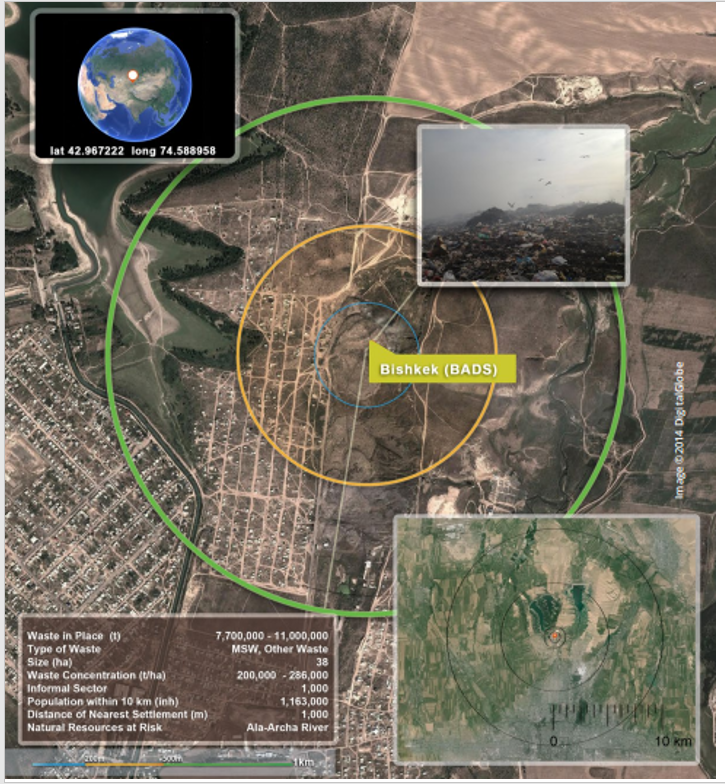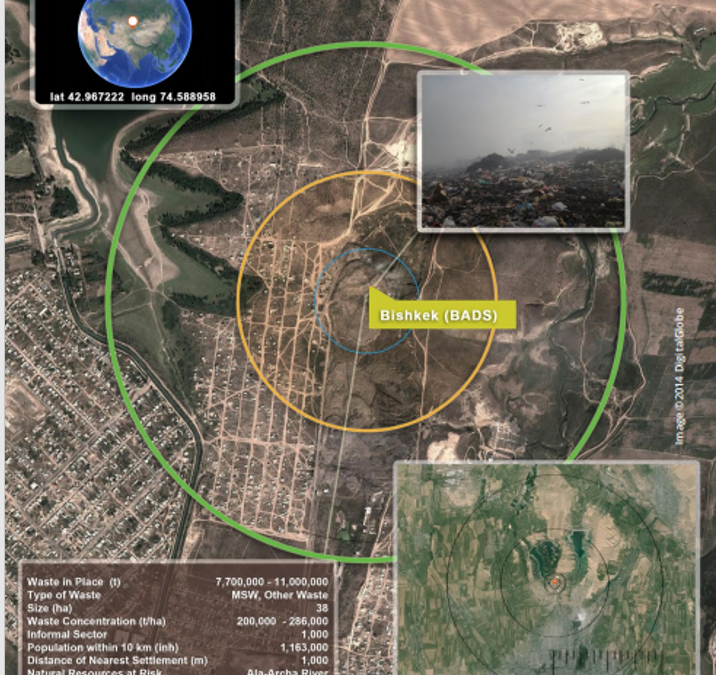The Bishkek municipal landfill polygon (henceforth BMLP or ‘landfill’) was opened in 1978 (but technically worked from 1972 onwards), at this time it was designed to receive the waste of 400,000 people. Currently, according to unofficial statistics around 1.2 million people live in the capital and the landfill site has expanded to cover over 46 hectares[1].
This is the only current place for disposing of waste. It is located 10 from the city and receives waste from the city and new housing developments (figure 1). The actual usage period of the landfill site has surpassed the regulatory usage period by more than 10 years. Today more than 24 million cubic metres of waste are stored on the landfill, even though the site was intended to hold 3.3 million cubic metres of municipal solid waste.

Figure 1. The location of the Bishkek Municipal landfill polygon, data from 2014[1].
The landfill is located in a region that has high levels of groundwater, which leads to filtration of the wastewater from the landfill into aquifers. Wind currents carry waste across the surrounding area, thus polluting the soil layers and surface water. The products of burning, eroding, and rotting waste pollute the atmospheric air. [3].
One of the pollutants from the landfill are waste gases, which are primarily composed of methane (50-70%), CO2, and a small quantity of non-methane organic compounds. Landfills are the third largest anthropogenic source of methane on the planet and are responsible for around 11% of global methane emissions[4].
Methane is a greenhouse gas and is the second largest contributor to global warming after carbon dioxide. It is 20-25 times more effective at maintaining heat in Earth’s atmosphere than CO2. Although it is a relatively short-lived gas, its presence in the atmosphere can last around 10±2 years. Reducing its concentration in the atmosphere would be an effective means of mitigating global warming in the coming years (i.e., within the next 25 years)[5],[6]
Download the full verion Methane Footprint
[1] https://economist.kg/novosti/vlast/2022/11/11/pochemu-musornyj-poligon-v-bishkeke-vse-eshhe-gorit-i-kuda-potratili-dengi-na-ego-likvidaciju/
[2] World’s Fifty biggest dumpsites, Waste Atlas 2014, https://d-waste.com/Atlasreport2014/Waste-Atlas-report-2014-webEdit.pdf
[3 Экологический обзор Кыргызской Республики. ГАООСИЛХ КР, 2009. http://aarhus.kg/wp-content/uploads/2017/01/Ecoobzor_2009.pdf
[4] Управление по охране окружающей среды США (U.S.EPA), 2011 г. ПРОЕКТ: Глобальные антропогенные выбросы парниковых газов (кроме CO2 ): 1990–2030 (отчет EPA 430-D-11-003), www.epa.gov/climatechange/economics/international.html.
[5] https://www.iea.org/articles/global-methane-emissions-from-oil-and-gas
[6] https://scied.ucar.edu/learning-zone/how-climate-works/methane




